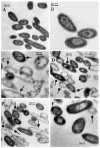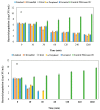The Effect of Citrus Essential Oils and Their Constituents on Growth of Xanthomonas citri subsp. citri
- PMID: 28420101
- PMCID: PMC6154457
- DOI: 10.3390/molecules22040591
The Effect of Citrus Essential Oils and Their Constituents on Growth of Xanthomonas citri subsp. citri
Abstract
Citrus bacterial canker (CBC) caused by Xanthomonas citri subsp. citri (Xcc), is the most devastating of the citrus diseases worldwide. During our study, we found that Essential oils (EOs) of some citrus cultivars are effective on Xcc. Therefore, it prompted us to determine the plant metabolites responsible for the antibacterial properties. We obtained EOs from some locally cultivated citrus by using a Clevenger apparatus and their major constituents were identified by gas chromatography/mass spectrometry (GC-MS). The effect of Citrus aurantium, C. aurantifolia, Fortunella sp. EOs and their major constituents were evaluated against Xcc-KVXCC1 using a disk diffusion assay. Minimal inhibitory and bactericidal concentration of the EOs and their constituents were determined using the broth microdilution method. C. aurantium, C. aurantifolia Eos, and their major constituents including citral, linalool, citronellal, geraniol, α-terpineol, and linalyl acetate indicated antibacterial effects against Xcc. The C. aurantifolia EO and citral showed the highest antibacterial activity among the tested EOs and constituents with inhibition zones of 15 ± 0.33 mm and 16.67 ± 0.88 mm, respectively. Synergistic effects of the constituents were observed between α-terpineol-citral, citral-citronellal, citral-geraniol, and citronellal-geraniol by using a microdilution checkerboard assay. Transmission electron microscopy revealed that exposure of Xcc cells to citral caused cell wall damage and altered cytoplasmic density. We introduced C. aurantifolia and C. aurantium EOs, and their constituents citral, α-terpineol, citronellal, geraniol, and linalool as possible control agents for CBC.
Keywords: C. aurantium; Citrus aurantifolia; citral; synergistic effect; transmission electron microscopy.
Conflict of interest statement
The authors declare no conflict of interest.
Figures




Similar articles
-
Chemical composition and antibacterial activity of essential oils from Citrus aurantifolia leaves and fruit peel against oral pathogenic bacteria.An Acad Bras Cienc. 2018 Apr-Jun;90(2):1285-1292. doi: 10.1590/0001-3765201820170847. An Acad Bras Cienc. 2018. PMID: 29898096
-
Characterization of three linalool synthase genes from Citrus unshiu Marc. and analysis of linalool-mediated resistance against Xanthomonas citri subsp. citri and Penicilium italicum in citrus leaves and fruits.Plant Sci. 2014 Dec;229:154-166. doi: 10.1016/j.plantsci.2014.09.008. Epub 2014 Sep 22. Plant Sci. 2014. PMID: 25443842
-
Chemical composition and anti-Xanthomonas citri activities of essential oils from Schinus molle L. fresh and dry leaves and of its major constituent spathulenol.Nat Prod Res. 2024 Oct;38(19):3476-3480. doi: 10.1080/14786419.2023.2249584. Epub 2023 Aug 22. Nat Prod Res. 2024. PMID: 37606013
-
Recent Advances in the Application of Antibacterial Complexes Using Essential Oils.Molecules. 2020 Apr 10;25(7):1752. doi: 10.3390/molecules25071752. Molecules. 2020. PMID: 32290228 Free PMC article. Review.
-
The Development of the Antibacterial Microcapsules of Citrus Essential Oil for the Cosmetotextile Application: A Review.Molecules. 2022 Nov 21;27(22):8090. doi: 10.3390/molecules27228090. Molecules. 2022. PMID: 36432192 Free PMC article. Review.
Cited by
-
A Dual Repeat Cis-Element Determines Expression of GERANYL DIPHOSPHATE SYNTHASE for Monoterpene Production in Phalaenopsis Orchids.Front Plant Sci. 2018 Jun 5;9:765. doi: 10.3389/fpls.2018.00765. eCollection 2018. Front Plant Sci. 2018. PMID: 29922327 Free PMC article.
-
Biological Activities of Citrus aurantium Leaf Extract by Optimized Ultrasound-Assisted Extraction.Molecules. 2023 Oct 24;28(21):7251. doi: 10.3390/molecules28217251. Molecules. 2023. PMID: 37959671 Free PMC article.
-
Effects of linalyl acetate on oxidative stress, inflammation and endothelial dysfunction: can linalyl acetate prevent mild cognitive impairment?Front Pharmacol. 2023 Jul 28;14:1233977. doi: 10.3389/fphar.2023.1233977. eCollection 2023. Front Pharmacol. 2023. PMID: 37576815 Free PMC article. Review.
-
Biocontrol Potential of Essential Oils in Organic Horticulture Systems: From Farm to Fork.Front Nutr. 2022 Jan 13;8:805138. doi: 10.3389/fnut.2021.805138. eCollection 2021. Front Nutr. 2022. PMID: 35096947 Free PMC article. Review.
-
Evaluation of Bacterial Perpetuation Assays and Plant Biomolecules Antimicrobial Activity against Cotton Blight Bacterium Xanthomonas citri subsp. malvacearum; An Alternative Source for Food Production and Protection.Plants (Basel). 2022 May 10;11(10):1278. doi: 10.3390/plants11101278. Plants (Basel). 2022. PMID: 35631704 Free PMC article.
References
-
- Graham J.H., Gottwald T.R., Cubero J., Achor D.S. Xanthomonas axonopodis pv. citri: Factors affecting successful eradication of citrus canker. Mol. Plant Pathol. 2004;5:1–15. - PubMed
-
- Pruvost O., Goodarzi T., Boyer K., Soltaninejad H., Escalon A., Alavi S., Javegny S., Boyer C., Cottyn B., Gagnevin L. Genetic structure analysis of strains causing citrus canker in Iran reveals the presence of two different lineages of Xanthomonas citri pv. citri pathotype A. Plant Pathol. 2015;64:776–784. doi: 10.1111/ppa.12324. - DOI
-
- Picchi S., Takita M., Coletta-Filho H., Machado M., Souza A. N-acetylcysteine interferes with the biofilm formation, motility and epiphytic behaviour of Xanthomonas citri subsp. citri. Plant Pathol. 2015;65:561–569. doi: 10.1111/ppa.12430. - DOI
-
- Leduc A., Traoré Y., Boyer K., Magne M., Grygiel P., Juhasz C., Boyer C., Guerin F., Wonni I., Ouedraogo L. Bridgehead invasion of a monomorphic plant pathogenic bacterium: Xanthomonas citri pv. citri, an emerging citrus pathogen in Mali and Burkina Faso. Environ. Microbiol. 2015;17:4429–4442. - PubMed
-
- Deng Z., Xu L., Li D., Long G., Liu L., Fang F., Shu G. Screening citrus genotypes for resistance to canker disease (Xanthomonas axonopodis pv. citri) Plant Breed. 2010;129:341–345. doi: 10.1111/j.1439-0523.2009.01695.x. - DOI
MeSH terms
Substances
LinkOut - more resources
Full Text Sources
Other Literature Sources
Miscellaneous

